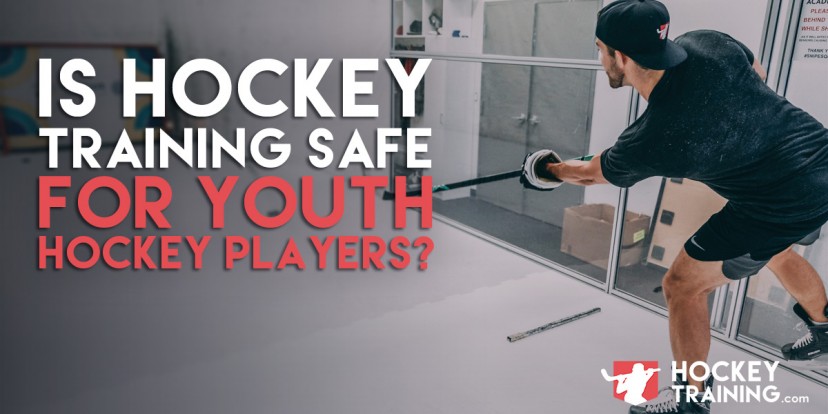Is Hockey Training Safe for Youth Hockey Players?

By Dan Garner, www.hockeytraining.com
We often get asked here at Hockey Training whether or not it is safe for younger athletes to do some training in order to become a better hockey player.
To be honest, this is a great question because I can totally get where every parent and coach is coming from because they only want what’s absolutely best for their young ones.
Today, I want to address this topic head-on so that we can end the conversation surrounding what’s really holding young players back from becoming the best versions of themselves.
Is Youth Hockey Training Safe?
The topic of training and safety for youth athletes has been circulating for decades, mostly just within the United States and Canada though as other countries have been routinely training their athletes at a young age for a long time now.
If you’re reading this article, I’m sure you have heard that any form of resistance training is unsafe for the youth demographic.
Some even go as far as saying it is bad for the joints and causes stunting in growth, yet there is no evidence to support these claims.
In reality, the safety risks of doing controlled dryland and/or gym-based exercise is far less than with football, hockey, running, baseball, gymnastics, martial arts, and many other popular sports.
The research in the world of biomechanics has clearly demonstrated that activities such as throwing, running, jumping, and hitting all impose much larger forces on the body than weight training ever could.
Beyond this, these activities have also been shown to place heavier stress on the growth plates of growing bones than weight training does — yet nobody seems to ever mention this and every parent seems to be ok with letting their kid perform all of these activities simultaneously.
I’d like to take a quick moment here and pull a direct quote an excellent review of the scientific literature that is found within the British Journal of Sports Medicine:
“Of note, injury to growth cartilage has not been reported in any prospective youth resistance training study that provided professional guidance and instruction.
Furthermore, there is no evidence that resistance training will negatively impact growth in height during childhood and adolescence.”
That is powerful stuff and should be incredibly conclusive for you since it is coming from an extremely well-respected medical journal and not just some random person echoing an old myth that needs to die.
Not Only Is It Safe, It’s Healthy!
Studies have shown that youth demographics who weight train have higher bone densities, which is the main contributor to bone strength (and not plate damage!).
Eastern European countries have found that children are significantly healthier when they resistance train at a young age and both the American Society of Pediatrics and the American Orthopedic Society for Sports Medicine have said that resistance training is positive for health and development.
Provided the program is made by a professional and that the technique is being supervised to ensure the movements are being performed properly in the gym, there seems to be no reason not to train and a whole lot of reasons to train.
To take the health and hockey performance legitimacy to the next level, I’d like to quote from the position statement that the National Strength and Conditioning Association did after reviewing the totality of research on youth training:
“Despite outdated concerns regarding the safety or effectiveness of youth resistance training, scientific evidence and clinical impressions indicate that youth resistance training has the potential to offer observable health and fitness value to children and adolescents, provided that appropriate training guidelines are followed and qualified instruction is available.
In addition to performance-related benefits, the effects of resistance training on selected health-related measures including bone health, body composition, and sports injury reduction should be recognized by teachers, coaches, parents, and health care providers”
More incredibly powerful stuff from the most scientifically respected strength and conditioning organization in the world.
If you read that correctly, you would know that not only can it help them with their health markers, and their fat loss, and their bone health, and their muscle gain…
But it also leads to fewer injuries in sports, not more!
Why Youth Hockey Athletes NEED To Resistance Train
When I say resistance train it doesn’t mean that they are bodybuilding, powerlifting, or throwing barbells over their head like a crazy Olympic lifter setting a new world record.
Proper youth training is not like that at all.
The term “resistance” simply represents any force being applied to the body, so yes, bodyweight-only training is a form of resistance training.
If the above benefits regarding fat loss, muscle gain, strength development, health improvement, bone density, and reduced injury risk weren’t enough for you…
Consider the fact that those are a byproduct of ANY resistance training program, but a hockey specific youth resistance training program will have all of those benefits PLUS improved speed, conditioning, and agility out on the ice.
At Hockey Training we don’t just make programs, we make the best and safest youth training programs on the market.
And now that you know that youth training is not only safe for hockey players but can actually be a total game changer for their performance on the ice, head on over to our programs section because we have just launched the most complete youth hockey programs available on the market today.
Inside you will find two new youth off-season programs and two new youth programs that were specifically designed to prep the athlete for tryouts.
Beyond completely “done for you” safe and effective youth workouts and full program designs, you will also get access to the accompanying manuals that give you the education you need to give your kid every advantage possible to dominate out on the ice.
Check out the new programs now and let’s get started!
